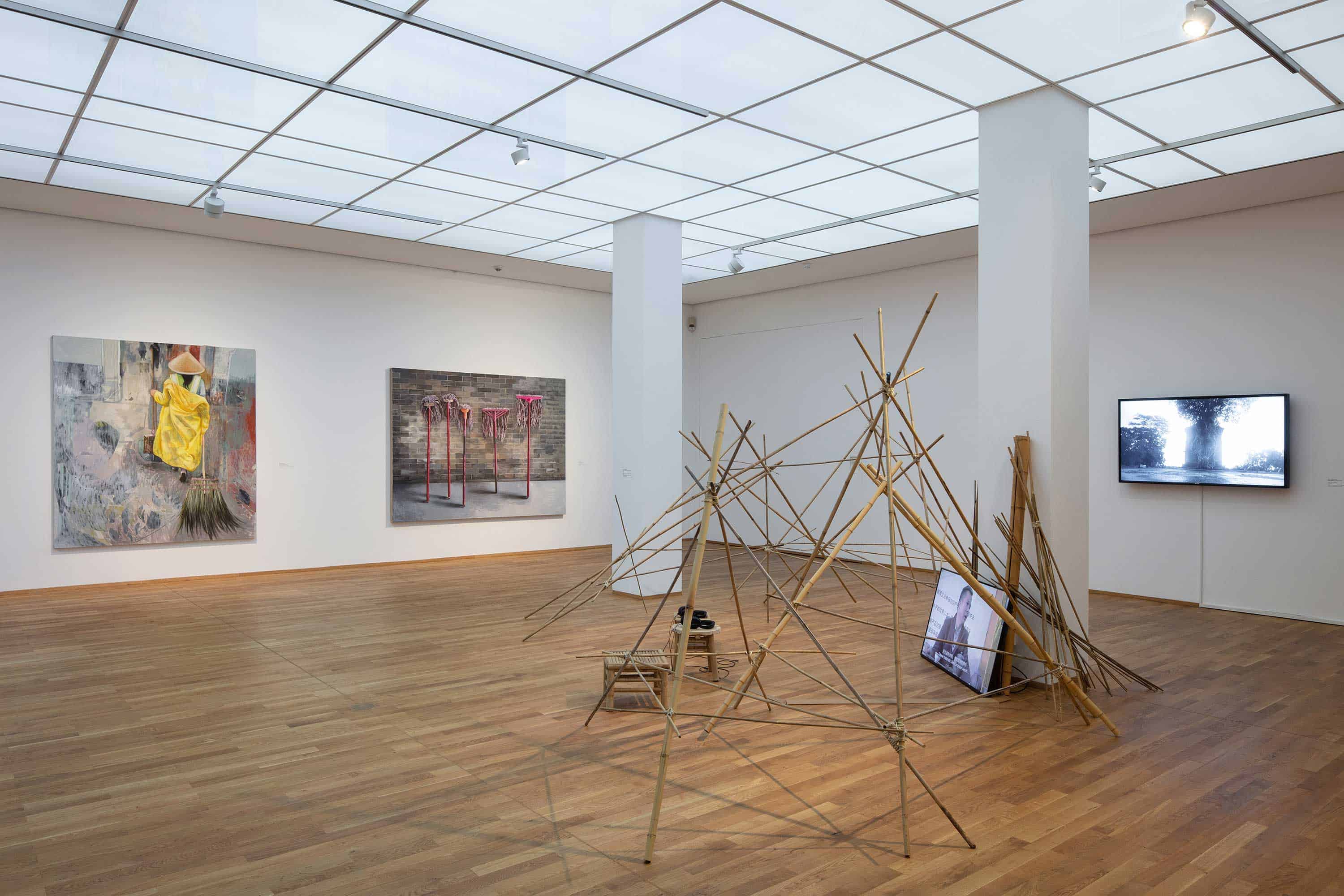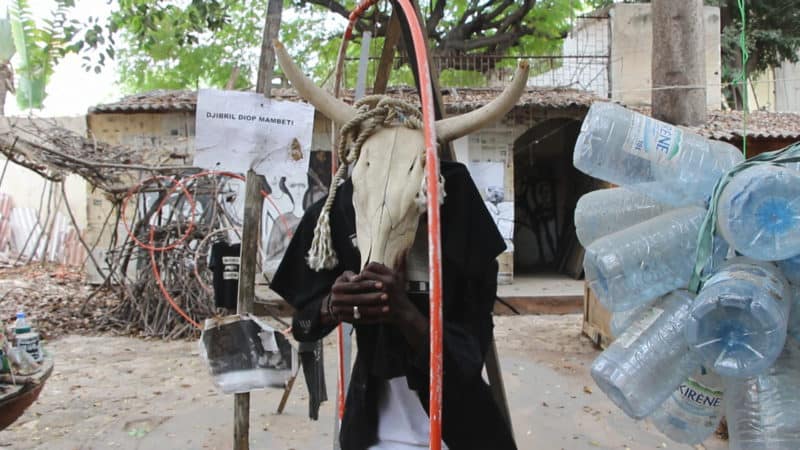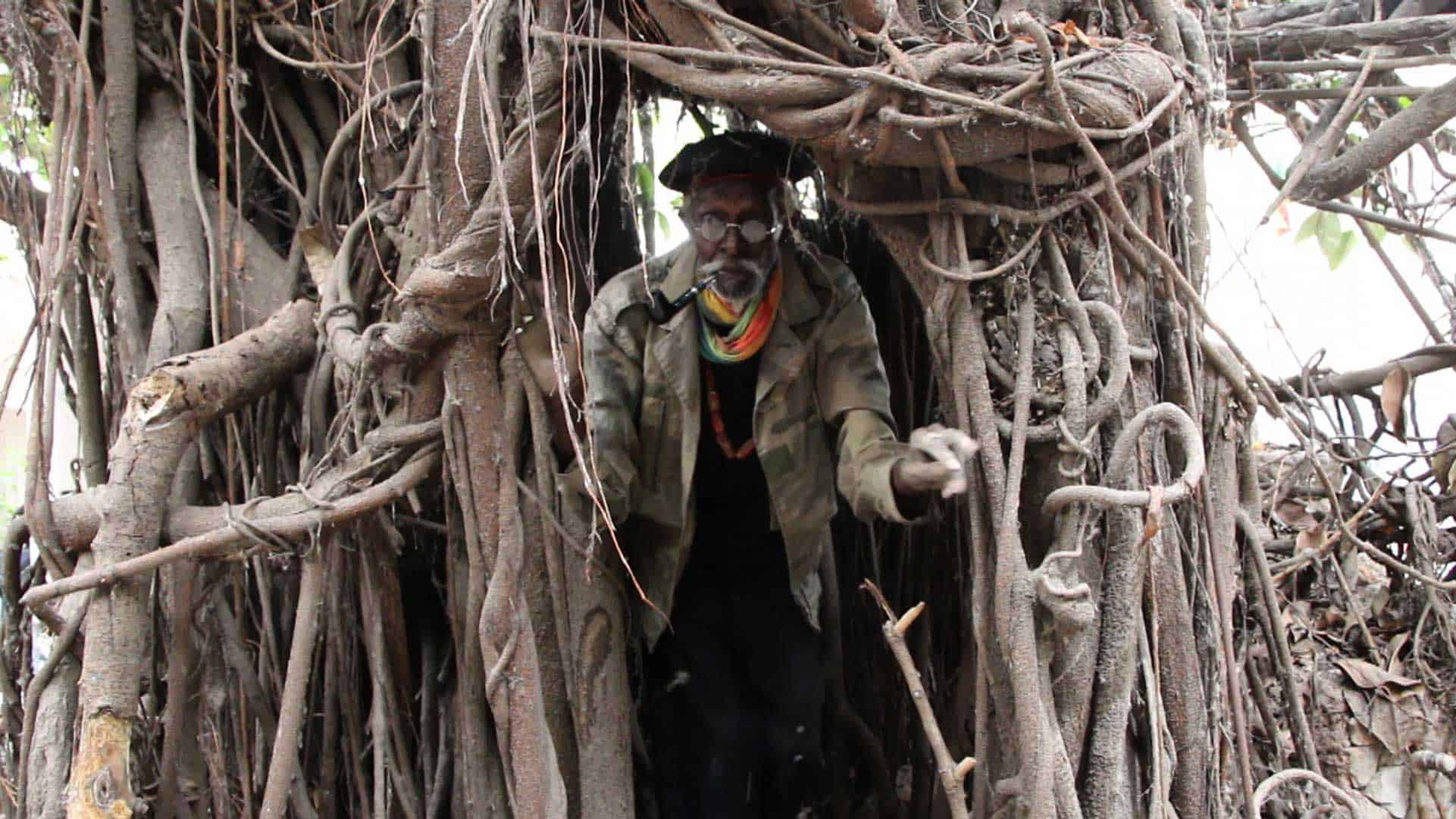Let’s get carried by Vistula River’s current. A female voice, bringing to mind rusałki – mythic Slavic water nymphs, lures visitors into entering the exhibition “How to talk with birds, trees, fish, shells, snakes, bulls and lions” curated by Ina Dinter and Aleksandra Jach at the Berlin Hamburger Bahnhof. An echoing chant calls us from the inside of a glistening shell-like ceramic sculpture by Agnieszka Brzeżańska. A scow under the emblem of the Flow / Przepływ collective is ready to depart. On its decks, the viewer-wanderer may rest and enjoy the recordings from an aquatic voyage, browse through the illustrated travelogues and glance on the ludic outfits. In films by Tomek Kopcewicz, Michał Szlaga, Emilia Sobczuk, Joanna Duda, Kuba Falkowski, Jakub Gliński and Museum Travel Agency (Tomek Pawłowski, Rafał Żarski), scenes from the floating artist residency are interwoven with daily life pictures and shots of river flux. The sun is up and the water is calm.

Ausstellungsansicht „How to talk with birds, trees, fish, shells, snakes, bulls and lions“ Hamburger Bahnhof – Museum für Gegenwart – Berlin, 2018 / Antje Majewski & Paulo Nazareth © VG Bild-Kunst, Bonn 2018 © Courtesy of the artist and Mendes Wood DM, São Paulo/New York/Brussels © Staatliche Museen zu Berlin, Nationalgalerie / Thomas Bruns
One of the strengths of this show is the ability to construct its own ecosystem at the heart of the vibrant city, filled with machines, high-rise buildings, and inhabitants in perpetual hurry. Set in one of the most prominent modern art museums in Berlin, the calm exhibition space is just a few hundred metres away from the Hauptbahnhof building – the embodiment of technological triumph, a futurist dream come-to-life. Being in such an individual ecosystem is almost a meditative experience. Sounds of nature accompany the viewer across the exhibition, aural layer strengthens the feeling of immersion.
Who are the Flow / Przepływ collective, to whom one of the opening spaces is devoted? Every summer it emerges as a migrating circus-like troupe of artists, appearing in the wildest parts of Poland and ready to perform in any circumstances. A flamboyant collective of nature enthusiasts. Like untamed waters, the activities of the group are almost impossible to categorise. Flow / Przepływ includes spontaneous performances, ephemeral collaborative projects and activism, promoting the welfare of the Vistula. All of that happens in relation to the annual flow on the waters of the longest Polish river. The s-shaped stream cuts the country in approximate halves. On its banks, from north to south, pleasurable events featured in the exhibition take place. According to the Vistula legend, two rebellious daughters of King and Queen Beskid delineated the river. Initially designated to guard the vital water source, they decided instead to spread its lifegiving potential beyond spatial constraints. As a women-lead initiative launched by Ewa Ciepielewska and Agnieszka Brzeżańska, Flow / Przepływ seems to carry this mythical legacy.

Tamás Kaszás ‘Escapist Story (from The Forest School)’ 2016-2018. Courtesy the artist and Kisterem Gallery
Not only is water associated with womanhood; when it comes to coexistence with flora, gardening or planting are stereotypically labelled as feminine too. To make something grow, to nurture it and take care of it – all of that is compared to female biology. It is reflected in language; Mother Nature is a woman after all. Domestic activities such as weaving and knitting share the same fate. As Alice Walker observes in her notable essay “In search of Our Mothers’ Gardens”, the final products of those are influxes of creative forces. Lush gardens and masterful textiles are underappreciated artworks of female ancestors.
Artists play with this notion on several levels, primarily by extensive work with textiles. “Vistula River’s textile” by Agnieszka Brzeżańska, a teal and tangerine dyed cotton drape convoluted in sinuous wave-like shapes, adorns the gallery wall. A blend of warm and cold tones echoes in other works, calling to mind a sunset over water juxtaposed with a chilling breeze, captured when the solar light is almost gone. Water knows the art of camouflage and dress up. Another large-scale fabric by Ewa Ciepielewska is covered with twisting and turning forms – only when we take a step back do abstract contours fall into place. The fervent declaration is being formed – “I am in love with the wild Vistula River”. Secondly, a range of ‘poor’ materials is used. Shells, sticks, stones, rubbers, Antje Majewski employs them all. In the neighbouring room she presents “E.F.A im Garten”. The Eco-Feminist Anarchy collective, co-founded by her, took on the subject of bulldozing green oases in the city. She gave a second life to the remains of allotment huts by including them in a multi-element installation. No less meaningful is Carolina Caycedo’s radical gesture of weaving her IUD (Intra Uterine Device) in a cone-shaped net-installation. When stepping further into the labyrinth of the Museum Hamburger Bahnhof rooms, we discover volunteer-made embroideries for Peace Guarani and Kaiowa Brasil. They hang from ropes like drying laundry, commemorating femicide, genocide and ethnocide of natives in Latin America.

Paulo Nazareth Ohne Titel/Untitled, aus der Serie / from the series: Mi Imagen de Hombre Exotico (Mein Porträt als exotischer Mann), 2011 Courtesy of the artist and Mendes Wood DM, São Paulo/New York/Brussels
The Berlin exhibition provides a space to reflect on various forms of exclusion – of the smaller, weaker, and non-profitable. The exclusion of empathy and care, of everything that stands in the way to capitalism. The figure of “the other”, the exoticised representative of the native tribe deprived of agency, reappears throughout the exhibition and materialises in the works of Paulo Nazareth and Hervé Yamguen. We confront alternative modes of human-plant relations, the ones often ridiculed by dominant western capitalistic rhetoric in Antje Majewski’s short documentaries. Xu Tan, through his interlocutor words, retells the stories of mothers, forests and an extraordinary woman from Kyoto, who almost lost her life while fighting with horrendous food waste. Additionally, Olivier Guesselé-Garai formulates a subtle warning in his dystopian black and white photographic landscapes. One artwork is disparate in its form – it is meant to be taken home. Paweł Freisler shows a caring approach towards a weak plant. Have you ever wondered what to do with an ill apple tree? The artist exchanged emails about this problem with Antje Majewski, what ultimately took the form of the two-sided take away poster with Piotr Życieński’s photograph on the reverse.
However, the show has its father figure and patron as well. A fair share of the exhibition space was committed to Issa Samb, a charismatic Senegalese painter. When entering through the staircase on the right from main entrance or continuing through the glazed passage, we are thrown into a significantly different space – possibly feeling intimidated by the shamanist figure and his expressive art. Plenty of artworks in the exhibition come to life in dialogue with the prophet of art driven by natural phenomena, who passed away just two years ago. We can observe the recording of his performative creative process, resembling children’s’ outdoor games. The question emerges – when and why did we lose this childish sensitivity to nature?

Antje Majewski ‘Yaadikone’ 2017. Courtesy the artist
Contemporary art is very much bonded to technology and tangled in the institutional framing, which forces artists to focus on urban spaces. For younger artists especially, it is not easy to oppose pressure and be able to create works in or about their towns. Tamás Kaszás presents an illustrated video-guide on becoming a farmer, a land caretaker and a forest explorer. Touching images of wildlife are juxtaposed with ironic captions, changing in relation to the slide-projector sound. With a humorous approach, the Hungarian artist reveals presumptions about rural life. However, when watching his touching video in a custom-build tent, the prospect of devoting oneself to creative work while observing small wonders of nature starts to look naïvely tempting.
Aside from the almost recreational atmosphere, the exhibition tackles serious contemporary issues. These artists and curators try to draw attention to the pressing ecological problems of climate change and the brutal extinction of endangered species. The title, long and causing troubles with repetition, is formulated this way not without a reason. Charged with an empathic message, it tries to include it all – fauna and flora, dangerous and manageable, petite and powerful. All the elements of the natural world that we have to come to terms with, if we want to inhabit this common ground a little longer. When balancing on the edge of a natural catastrophe, a conscious and careful coexistence looks like the only way of human survival.
Written by Natalia Dorocka
How to talk with birds, trees, fish, shells, snakes, bulls and lions
The exhibition took place between 16.11.2018 and 12.05.2019
Hamburger Bahnhof – Museum für Gegenwart – Berlin

Issa Samb & Antje Majewski, Rue Jules Ferry 17, 2016, HD Video, Farbe, Ton, Courtesy of the artist and neugerriemschneider, Berlin, © VG Bild-Kunst, Bonn 2018







